The Current Approach to Enterprise Mobile Application Development

According to Precedence Research, the global mobile app market is valued at $161 billion and is expected to reach $1.191 trillion by 2032. There is an anticipated staggering compound annual growth rate (CAGR) of 22% from 2023 to 2032. Moreover, according to Verified Market Research, the enterprise mobile app market size stands at $235 billion and is projected to reach $471 billion by 2030, with a CAGR of 8%.
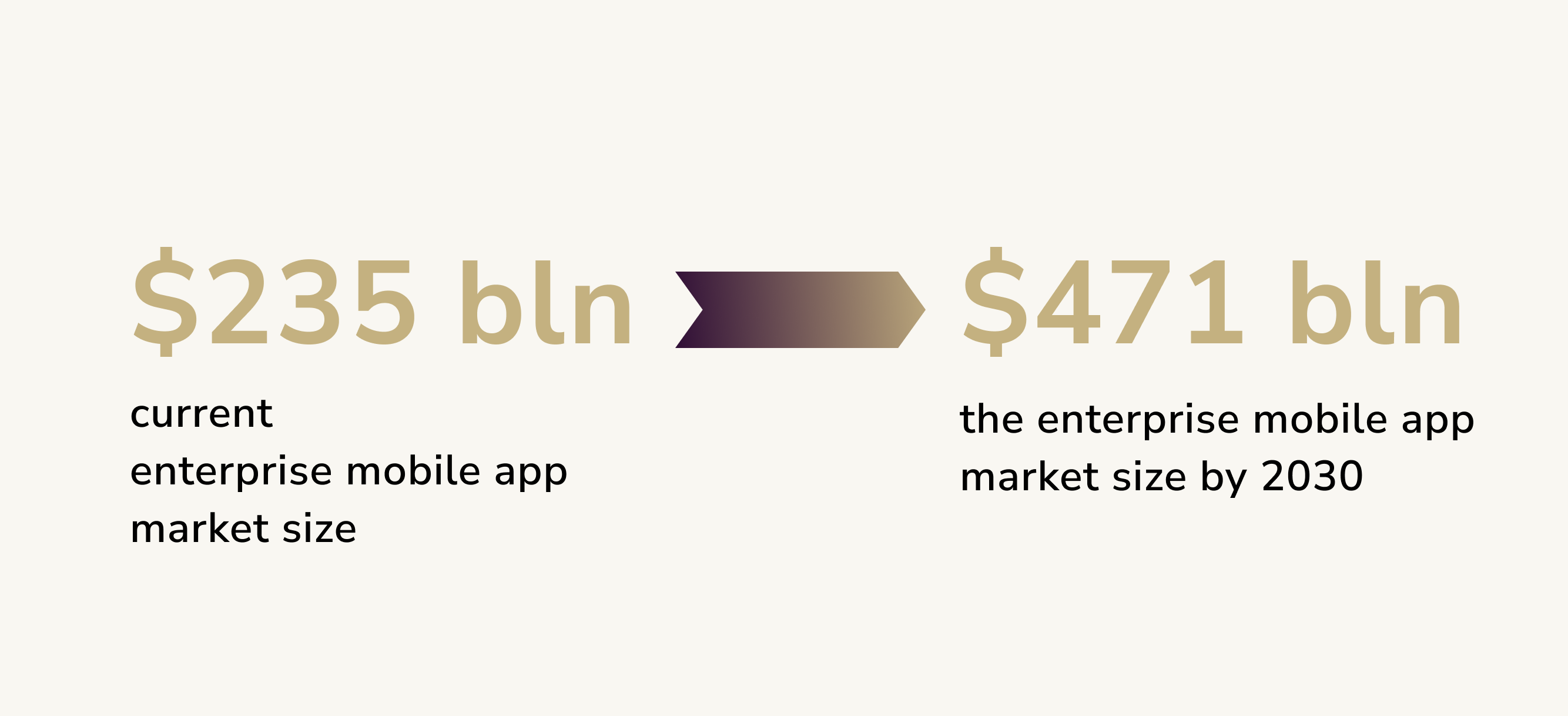
This evidence shows enterprise mobile app market size does not expand as rapidly as the overall mobile app market. However, enterprise mobile app development presents a big chunk of overall custom mobile app development. Keeping that in mind, let’s explore the ins and outs of enterprise mobile application development while focusing on its benefits and the role of factors like agile, UI/UX, and security. Besides, one should offer some distinct steps for approaching enterprise mobile app development while illustrating key trends in this segment to follow in 2023.
What Is Enterprise Mobile Development?
Enterprise mobile development is a sophisticated software system that addresses an organization's specific requirements. The app should be developed in alignment with a company's overall strategy and enable certain functions on mobile devices. Enterprise mobile app development aims to create user-friendly software that handles multiple complex data types and adheres to the latest security standards.
Enterprise Application Development Services Benefits
Enterprise mobile applications are purposely crafted for individual businesses to empower employees to be more productive, enhancing overall organizational efficiency. At this point, the phenomenon brings several distinct benefits:
- Transaction control and additional payment feature. Enterprise mobile app development advantages. This aspect is precious for retailers and businesses involved in e-commerce payment systems. A transaction-focused mobile app can enhance financial management, heighten awareness of payment deadlines, and set notifications for crucial parameters.
- Enhanced data management. An enterprise mobile app can refine data processing, analysis, verification, or modification processes, significantly impacting overall business efficiency.
- Reducing paperwork and human error. The benefits mentioned above contribute to decreased paperwork and automation of tasks, allowing professionals to concentrate on strategic goals and complex challenges.
- Mobile tracking of employee statuses. An enterprise mobile app development service provider can assist in creating software that essentially relocates the office beyond physical buildings. This enables monitoring of employee progress, while employees can report their progress through a mobile app.
- Streamlining employee onboarding and certification. Enterprise mobile apps can significantly simplify the onboarding process for large corporations. Automating a few simple steps can save significant time and effort for HR professionals. An app that manages employee certification information can also optimize the HR department's work.
- Optimal customer support. Enterprise mobile applications can be the ultimate solution for providing the best possible customer support. Mobile apps can easily manage 24/7 support for basic client inquiries. This allows human experts to prioritize and handle more core business functions and competencies. Incorporating innovations like fraud detection with machine learning into mobile enterprise applications can help address and prevent specific security issues.
At this point, with all the advantages of enterprise application development, one can suggest that the phenomenon is worth exploring in detail. Particular attention should be made to aspects making enterprise application development different from other software products.
What Differentiates Enterprise Application Development from Other Software Products?
Enterprise mobile app development focuses on creating apps that fulfill company needs. Users of these apps often include employees, customers, and stakeholders, with the primary goal being to streamline internal business processes.
Enterprise mobile app development differs from consumer mobile apps in several ways:
- Enterprise apps interact with standard databases and require rapid data transmission, similar to any business system that demands scalability and robust security. In contrast to social applications, mobile enterprise app development must ensure reliability across various device types and platforms, as errors can be costly for a company over time.
- Integrating an enterprise app to manage organizational structures and automating testing methods present unique challenges. When developing business applications, app distribution and regulatory constraints also vary to accommodate software architectures and receive positive feedback.
Overall, the evidence shows there are particular benefits of enterprise application development, and it is different from other software products. The next thing worth exploring is all about enterprise application development types.
Enterprise Mobile Application Types
In a nutshell, enterprise application development comes in three different forms:
- Employee Level Apps. These applications focus on addressing specific functionalities required by clients and streamlining internal operations and processes for employees. For example, an app with messaging features like Slack reduces the need for excessive communication between team leaders and software developers regarding desired attributes, making workflows more efficient.
- Departmental Level Apps. These mobile apps aim to enhance productivity within individual departments of an organization. For instance, incorporating an innovative HR management system through a mobile app like BambooHR can boost the efficiency of the HR department, enabling them to resolve employee issues more swiftly and effectively, as well as manage time-off requests and performance evaluations.
- Company-Level Apps. Designed to connect various departments within an organization, these mobile enterprise apps establish a secure network that simplifies communication and collaboration. By enabling employees to easily schedule meetings with the CEO or access official company documents through apps like Microsoft Teams or Asana, these apps help streamline workflows and eliminate time-consuming procedures, improving overall operational efficiency.
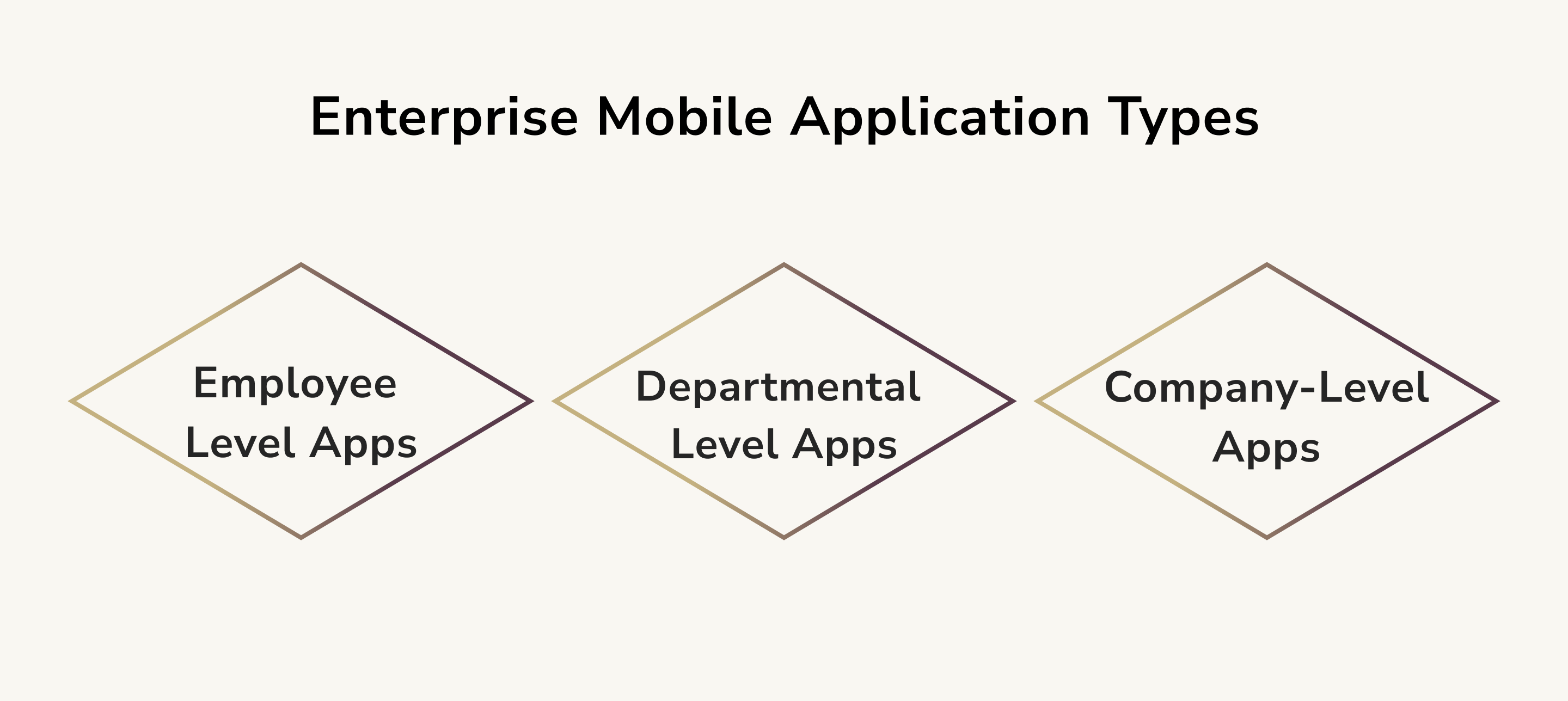
With the types of mobile applications above, one can choose the right enterprise application development approach. Besides, remember that selecting the right type of enterprise mobile app development makes it easier to deal with different types of mobile application testing. Going further, let’s explore the notion of cloud-based infrastructure and its importance within enterprise mobile app development.
What Is a Cloud-based Infrastructure?
The adoption of cloud-based infrastructure has profoundly influenced the development and maintenance of mobile enterprise apps, offering numerous advantages and altering the conventional approach to app development. Here are some ways cloud-based infrastructure has redefined the enterprise mobile app development landscape:
- Improved scalability. The cloud-based infrastructure allows developers to scale their applications swiftly and effectively. As the app's user base or workload expands, developers can allocate more resources to meet the increased demand, ensuring consistent performance even during high traffic or rapid growth.
- Higher cost efficiency. Employing a cloud-based infrastructure for developing and maintaining a mobile enterprise app can be more cost-effective than traditional on-premises infrastructure. Cloud providers usually employ a pay-as-you-go pricing model, allowing businesses to pay only for the resources they use, eliminating the need for significant upfront investments in hardware and reducing ongoing maintenance expenses.
- Accelerated development and deployment. Cloud-based infrastructure offers developers access to a broad range of pre-built services and tools, expediting development. These resources allow developers to build, test, and deploy their applications faster, shortening their time-to-market. Furthermore, the cloud supports continuous integration and continuous deployment (CI/CD) practices, which optimize the development process and enable quicker release cycles.
- Enhanced security. Cloud providers implement robust security measures to safeguard data and applications hosted on their platforms. Features such as encryption, access control, and secure data storage help protect sensitive information. By utilizing the security capabilities of cloud-based infrastructure, businesses can mitigate data breach risks and defend their mobile apps from potential threats.
- Streamlined maintenance and updates. Cloud-based infrastructure simplifies developers' management of updates and maintenance tasks. Cloud providers handle underlying hardware and software updates, allowing developers to concentrate on enhancing the app's functionality and features. Moreover, cloud-based infrastructure facilitates the rollout of updates to users, ensuring they always have the latest app version.
- Global accessibility. Cloud-based infrastructure ensures mobile enterprise apps are available worldwide with an internet connection. This global access allows users to interact with the app and its data anytime, boosting collaboration and productivity for geographically dispersed teams.
Adopting cloud-based infrastructure has revolutionized mobile enterprise app development and maintenance by delivering scalability, cost efficiency, accelerated development and deployment, heightened security, streamlined maintenance, and global accessibility. These benefits make cloud-based infrastructure appealing for businesses aiming to optimize their enterprise mobile app performance and refine their development processes.
Process of Custom Enterprise Mobile App Development
With all we know about enterprise mobile app development, it is time to explore some steps needed to build a custom enterprise mobile app. In short, you need to follow these 9 steps:
Establishing business objectives
When developing enterprise mobile applications, consider creating solutions tackling relevant issues in this field. Some crucial objectives to account for during the planning phase include the following:
- Specifications — clearly define the app's technical requirements and desired features.
- Expected outcomes — identify the expected results and improvements the app will bring to the organization.
- Implementing procedures — establish guidelines and best practices for the app's deployment and usage.
- Well-defined business solutions and processes — outline how the app will support and streamline existing business operations.
- Business process management — Ensure the app aligns with the company's overall business process strategy.
- Business operations — understand the app's role in supporting the organization's day-to-day activities.
- Business objectives — align the app's development with the company's strategic goals and objectives.
- Business model — determine how the app will contribute to the company's revenue generation or cost savings.
- Business logic — ensure the app's functionality aligns with the organization's processes and decision-making.
- Business intelligence — incorporate data analytics and reporting features to support informed decision-making.
Budget calculation
The next step is gathering customer requirements, establishing solutions, and setting KPI success measures. Determine the specific requirements for enterprise mobile app development based on your industry. When budgeting for your mobile enterprise app, consider the following:
- Customer acquisition cost (CAC) — calculate the expenses associated with acquiring new users for the app.
- Churn rate — estimate the rate users will stop using the app and incorporate this into revenue projections.
- Development costs — account for the expenses of designing, building, and testing the app.
- Revenue generation model — identify the app's monetization strategy, such as subscriptions or in-app purchases.
- License acquisition — factor in the cost of acquiring necessary licenses and certifications for the app.
- Platform fees — consider any costs associated with publishing the app on specific platforms, such as the Apple App Store or Google Play Store.
- Resource allocation — allocate financial and human resources to ensure successful app development, deployment, and maintenance.
Defining technical requirements
Enterprise mobile apps require clear and concise technical specifications. Some key aspects to consider are:
- Functional specifications — detail the app's features, capabilities, and intended user interactions.
- Performance specifications — outline the expected performance levels, such as load times, response times, and device compatibility.
- Interface specifications — describe the app's user interface, including layout, navigation, and visual design elements.
- Design specifications — provide guidelines for the app's overall look and feel, adhering to the organization's branding and design standards.
- Development requirements — list any specific tools, technologies, or frameworks needed for enterprise app development.
- Maintenance terms — establish a plan for ongoing app maintenance, including bug fixes, updates, and feature enhancements.
- Data analytics — incorporate data collection and analysis capabilities to measure app performance and user behavior.
Platform selection
Selecting the right platform for your enterprise mobile app is a critical decision. This step is based on these actions:
- Start by familiarizing yourself with cross-platform digital transformation trends and considering the various digital transformation tools available for app development.
- Second, remember that mobile enterprise apps can be developed for multiple platforms, including iOS, Android, or Sencha.
- Third, consider factors such as target audience, device compatibility, and development resources when choosing a platform.
Wireframe design
Next, creating a wireframe is an essential step in enterprise mobile app development. It serves as a visual blueprint for the app structure and functionality. To ensure a successful wireframe design, follow these phases:
- Conduct mobile apps enterprise meetings — gather stakeholders and team members to discuss the app's objectives, features, and user expectations.
- Communicate with stakeholders — maintain open communication to ensure their input and requirements are considered throughout the design process.
- Determine navigation requirements — identify and outline the app's navigational structure, ensuring a smooth and intuitive user experience.
- Share wireframe — present the wireframe to the team and stakeholders for review, feedback, and approval.
- Use simple shapes and views — utilize primary forms and elements to represent the app's layout and functionality, focusing on user flow and interaction.
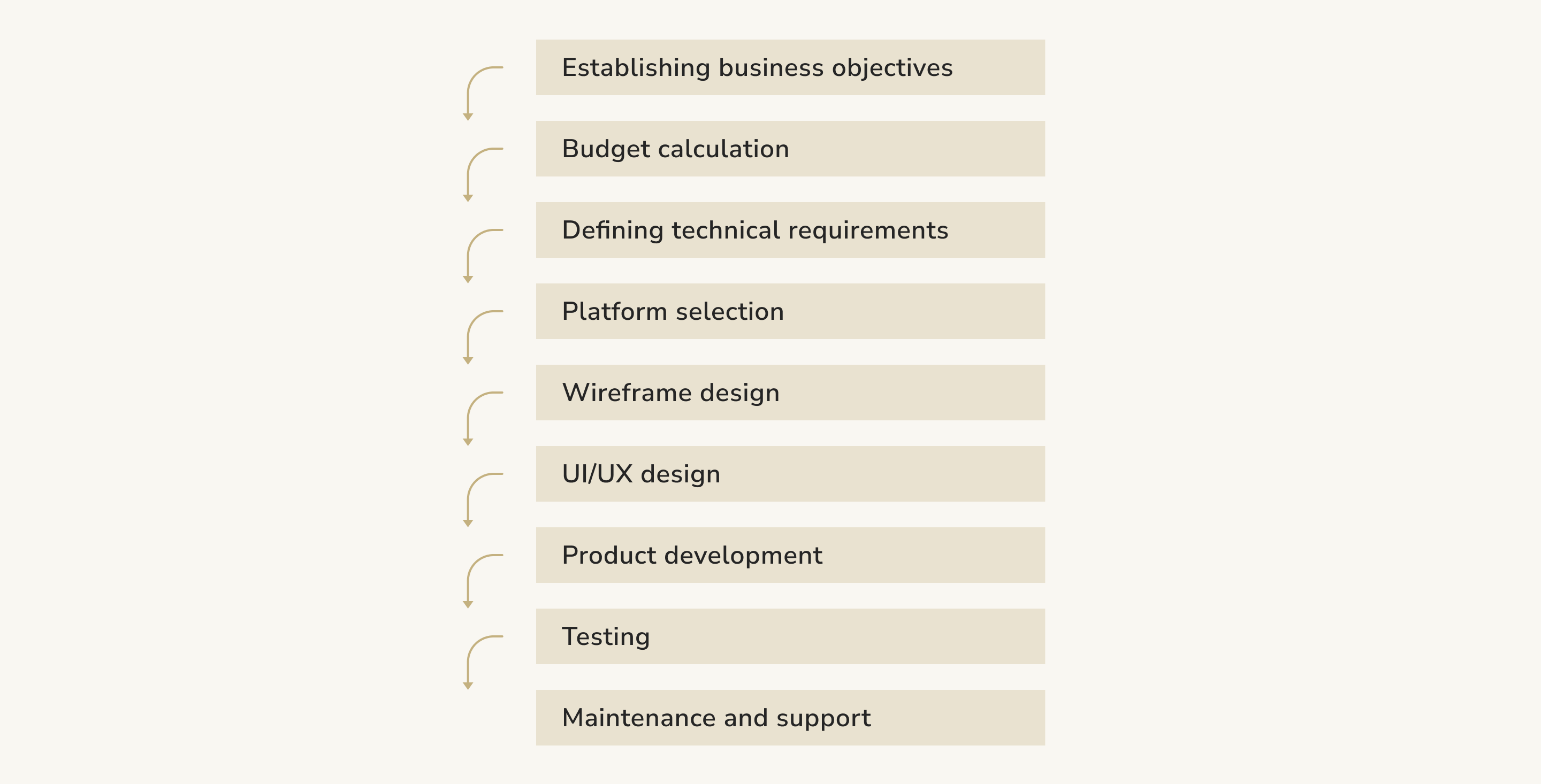
UI/UX design
A successful enterprise mobile app should have a straightforward, concise, and cohesive UI/UX design. It means users must be able to easily navigate the software product and use it with high user experience satisfaction. To achieve this, enterprise mobile application development companies typically ensure the following elements are addressed:
- Prototyping — develop an interactive prototype to simulate the app's functionality and interactions, facilitating early user testing and feedback.
- UX wireframing — refine the wireframe to incorporate feedback and create a detailed blueprint for the app's UI and UX design.
- User journey map — map the user's journey through the app, highlighting key touchpoints, interactions, and potential pain points.
- Graphic design — design the app's visual elements, such as icons, typography, and color schemes, in line with the company's branding and design guidelines.
- Usability testing — conduct usability tests to evaluate the app's performance and user satisfaction and identify areas for improvement.
Product development
With the design ready and prototypes tested, it is time to develop the product. In such a case, enterprise mobile application development should focus on the following aspects:
- Outcomes — establish clear goals and objectives to guide development and measure success.
- Security — implement robust security measures to protect sensitive data and ensure user privacy.
- Quality — focus on delivering a polished, reliable app that meets or exceeds user expectations.
- Priority — prioritize features and functionality based on user needs, business objectives, and resource constraints.
Testing
After enterprise app development is done, and you have either an MVP or the end product, you need to return to testing. Yet, this one is more rigorous than the one conducted with the design. In such a case, common product testing methods include
- Unit test — test individual app components to ensure proper functionality.
- Integration test — test the app's interaction between components and modules.
- Acceptance test — evaluate the app's overall functionality, performance, and user experience to ensure it meets the established requirements.
Maintenance and support
Last but not least, maintaining and supporting the enterprise mobile app after launch is essential for continued success. Consider the following standards when planning for maintenance and support:
- Condition-based maintenance — monitor the app's performance and usage to identify and address issues proactively.
- Corrective maintenance — resolve bugs, errors, and other problems that arise during the app's lifecycle.
- Preventive maintenance — perform regular updates and optimizations to maintain the app's performance and security.
- User experience design — continuously refine the app's UI and UX based on user feedback and evolving needs.
- User experience — monitor and improve user satisfaction through ongoing enhancements and support.
- User consent — ensure compliance with data privacy regulations and obtain user consent as needed.
The Role of Agile Development Methodologies in Enterprise Mobile Apps
Agile development approaches, such as Scrum and Lean, have become the standard for enterprise mobile app development as they effectively tackle this type of work's unique challenges and demands. These methods emphasize cooperation, adaptability, and ongoing enhancement, making them ideal for the rapidly changing world of mobile technology.
Here are some reasons why agile methods are particularly well-suited for enterprise mobile app development:
- Swiftly evolving requirements. The mobile app sector experiences rapid changes in customer preferences, market demands, and technological advancements. Agile methods enable development teams to adapt quickly to these shifts by adopting an iterative process. This adaptability allows teams to respond to new requirements, incorporate feedback, and make improvements throughout the development journey.
- Quicker time-to-market. Agile methods like Scrum and Lean stress the importance of quickly delivering a functional, high-quality product. By dividing the development process into smaller, manageable segments, teams can concentrate on providing a minimum viable product (MVP) and iterating on it based on user feedback. This strategy helps businesses bring their apps to market more quickly, providing a competitive edge.
- Enhanced collaboration and communication. Agile methods promote improved communication and cooperation between developers, designers, product owners, and other stakeholders. Regular meetings, stand-ups, and sprint reviews to ensure everyone is aligned and potential issues are addressed promptly. This collaborative approach results in a more efficient development process and a superior end product.
- Ongoing improvement and learning. Agile methods encourage teams to reflect on their performance and learn from their experiences. Retrospective meetings allow teams to identify areas for improvement and implement changes in the next iteration. This focus on continuous improvement helps teams refine their processes and consistently deliver better products.
- Increased customer satisfaction. By integrating user feedback throughout the development process, agile methods ensure that the final product meets user needs and expectations. This customer-centric approach leads to higher user satisfaction and increased adoption of the mobile enterprise app.
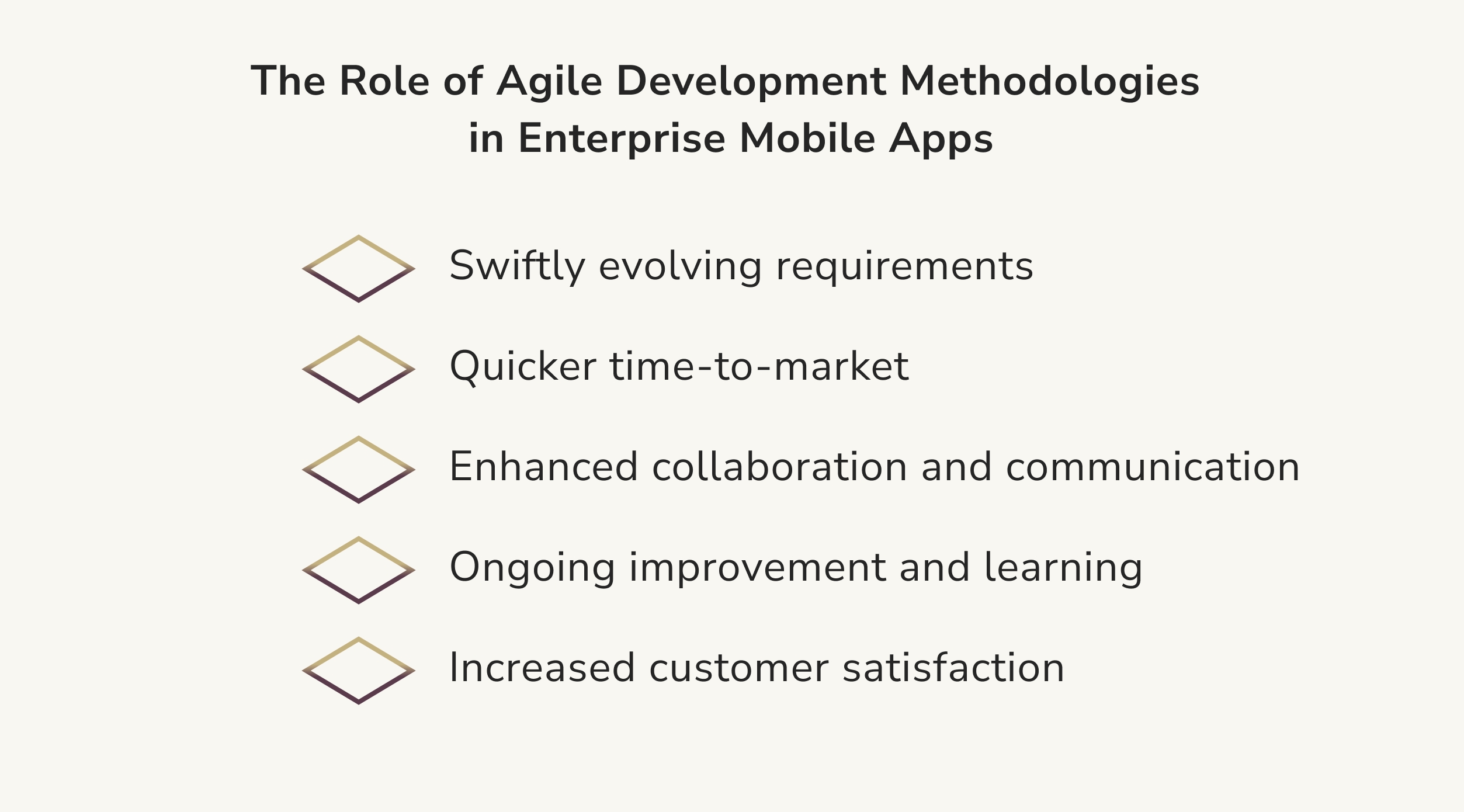
In such a case, agile development approaches are well-suited for enterprise mobile app development because they provide the flexibility, speed, and collaboration necessary to navigate mobile technology's constantly evolving landscape. By adopting these methods, businesses can ensure that their mobile apps remain relevant, user-friendly, and competitive.
The Importance of UX in Enterprise Mobile App Development
UX plays a critical role in the success of mobile enterprise applications. It impacts how users interact with and perceive the app. By focusing on UX design, businesses can ensure their mobile apps meet functional requirements and provide users with a seamless, intuitive experience. A well-designed UX can significantly improve adoption and retention rates for mobile enterprise apps, offering several key benefits:
- Enhanced user satisfaction. A positive user experience is essential for maintaining user satisfaction. By designing an app with a straightforward, easy-to-navigate interface and valuable features, businesses can ensure that their users enjoy the app and are more likely to continue using it.
- Increased productivity. For mobile enterprise apps, user experience is closely tied to productivity. A well-designed UX allows users to access critical information and complete tasks more efficiently, resulting in time savings and improved overall productivity for the organization.
- Lower support costs. Users who can easily understand and navigate an app are less likely to encounter problems or require assistance. This reduces the need for support resources, such as help desks or training materials, ultimately lowering the total cost of ownership for the app.
- Improved adoption rates. A user-friendly app is more likely to be adopted by employees, as they will feel more comfortable using the tool to accomplish their tasks. This can lead to higher adoption rates across the organization, ensuring the app's benefits are fully realized.
- Positive brand perception. A mobile enterprise app with a well-designed user experience can enhance a company's brand perception. Users will associate the app's ease of use and functionality with the organization, leading to a more positive company image.
- Reduced churn and increased retention. A compelling user experience can keep users engaged with the app, reducing the likelihood of abandoning it for alternative solutions. By focusing on UX design, businesses can improve user retention and reduce churn, maximizing the return on investment for their mobile app development efforts.
Designing enterprise mobile apps focusing on user experience is essential for driving adoption and retention. By creating a user-friendly, intuitive app, businesses can ensure that their users are satisfied, productive, and engaged, ultimately contributing to the app's overall success and the organization's bottom line.
The Role of Security in Mobile Enterprise App Development
The significance of security in enterprise apps cannot be overstated. Here are some security tips for enterprise applications:
- Plan for security early on. Create a security checklist during the planning phase of enterprise app development. Make every effort to anticipate potential security threats during or after the app's launch.
- Evaluate the development framework. Investigate the most recent software and platforms, as legacy software can be susceptible to hacker attacks. To ensure data protection, avoid using outdated systems whenever possible.
- Follow encryption methods and standards. Establishing a gateway for an initial security audit is crucial. This makes it much more difficult for unauthorized individuals to infiltrate your organization's system and steal enterprise information.
- Robust user authentication. This fundamental security component is crucial for enterprise mobile app development. To enhance security, implement two-factor and multi-factor authentication, leveraging technologies such as the OpenID Connect protocol and OAuth 2.0 authorization framework.
Respectively, with security measures up and running, one can expect a smooth enterprise mobile app development process. It is vital not to underestimate the importance of security measures coming with enterprise app development.
10 Key Trends in Enterprise Mobile App Development
As technology continues to evolve, the enterprise mobile app development landscape is also witnessing rapid changes. Here are some emerging trends shaping this industry's future.
Artificial Intelligence (AI) and Machine Learning (ML)
AI and ML technologies are increasingly integrated into enterprise mobile applications to provide advanced analytics, automate tasks, and optimize processes. These technologies enable businesses to gain valuable insights, improve decision-making, and enhance user experiences.
Internet of Things (IoT) Integration
The growing popularity of IoT devices has increased the demand for enterprise mobile apps that interact with connected devices. IoT integration enables businesses to monitor and manage various operations remotely, improving efficiency and cost savings.
Cross-Platform Development
To reach a broader audience, businesses opt for cross-platform mobile app development using frameworks like React Native and Flutter. These tools allow developers to create apps that work seamlessly on multiple platforms, including Android and iOS, saving time and development costs.
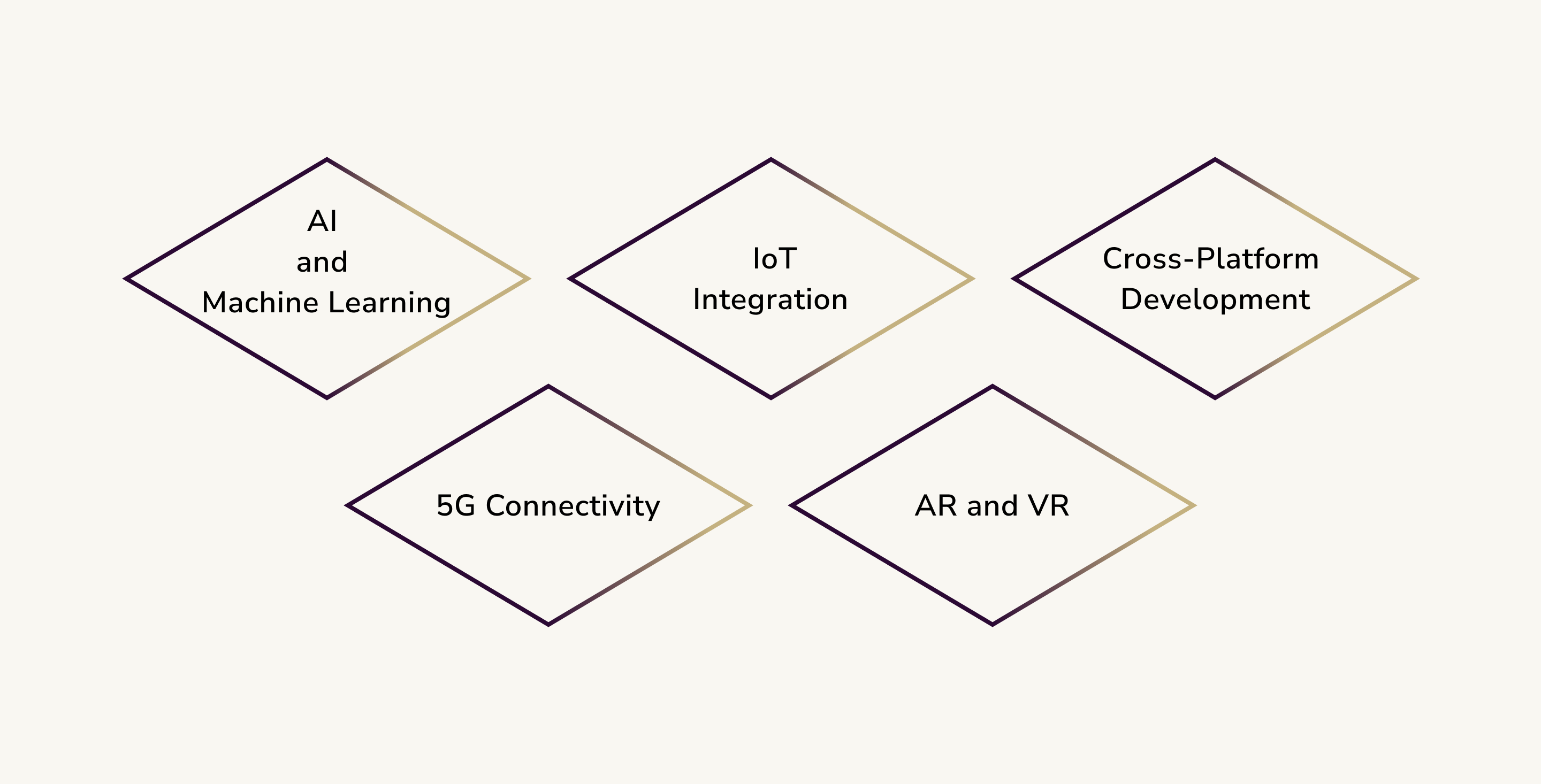
Augmented Reality (AR) and Virtual Reality (VR)
AR and VR technologies are finding their way into enterprise mobile applications, providing immersive experiences for training, remote assistance, and product visualization. These technologies can potentially transform industries like healthcare, retail, and manufacturing.
5G Connectivity
The rollout of 5G networks promises to bring faster data transfer speeds, reduced latency, and improved network reliability. This advancement will enable enterprise mobile applications to support more complex, data-intensive tasks and enhance real-time communication.
Low-Code Application Platforms
Low-code platforms have gained traction alongside AI-driven software development. These platforms offer user-friendly visual interfaces with straightforward logic and drag-and-drop features, enabling individuals without formal coding expertise to create or modify applications for various purposes, such as enterprise mobile and business apps.
As skilled developers are costly and scarce, low-code platforms help bridge the gap in software development. These platforms support the growing shift toward enterprise application development using Software as a Service (SaaS), Platform as a Service (PaaS), and Serverless systems. With low-code platforms, non-programmers can create and implement applications without extensive coding knowledge. Major low-code platforms incorporating AI include Google's AppSheet and Microsoft's Power Platform.
DevOps
The DevSecOps approach promotes integrating security as code in software development. DevOps as a service enables security practitioners to adapt and evolve their existing processes, similar to how Agile helps business and development teams collaborate more effectively.
Cross-functional teams, including enterprise architects, developers, security specialists, and operations, can deliver applications more quickly and efficiently. Policy-based automation and CI/CD streamline the development process, improving time to market and providing a competitive edge.
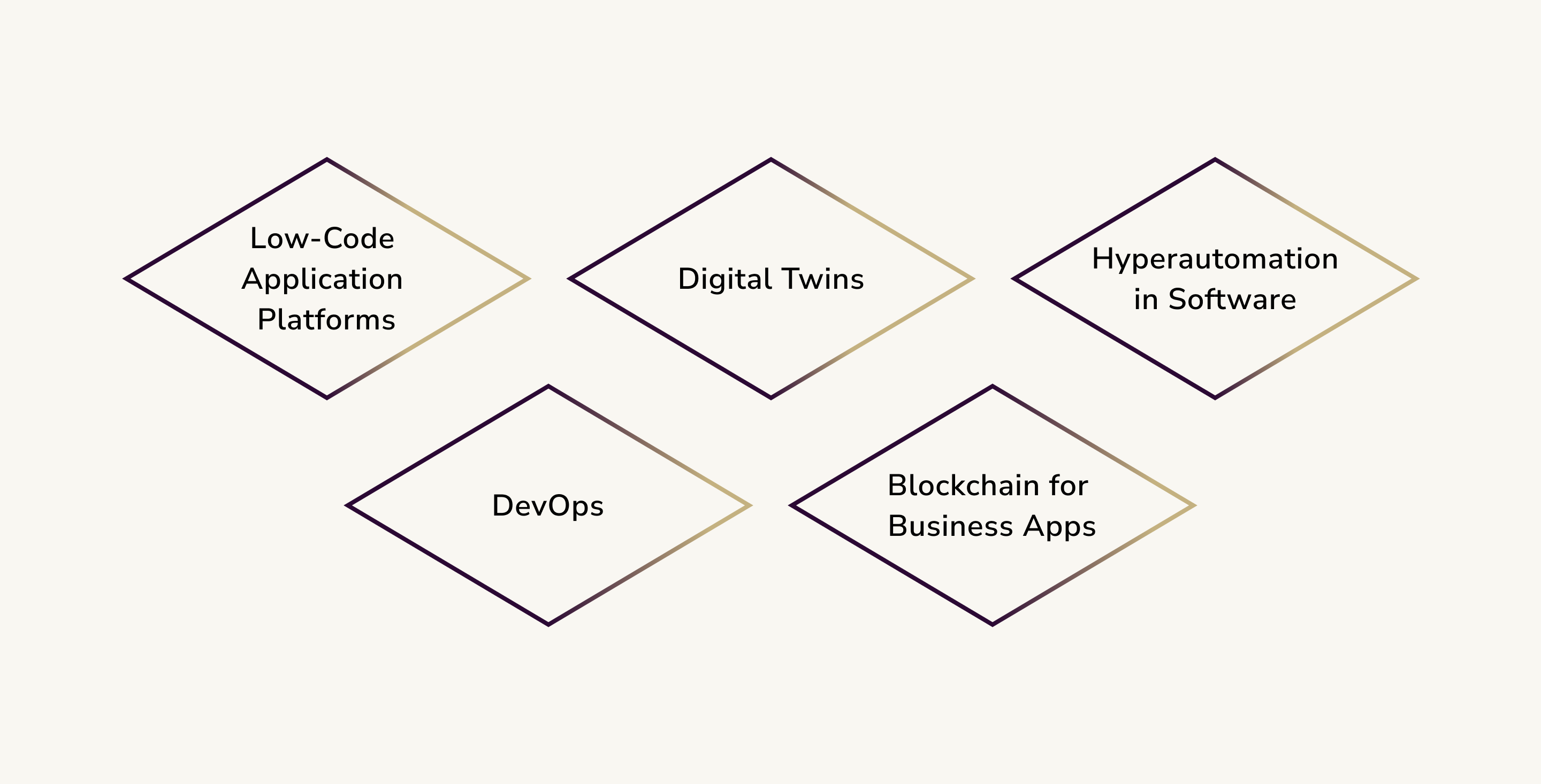
Digital Twins
This trend leverages big data and predictive analytics to optimize business performance. A digital twin is a virtual representation of a physical object, process, or service used to simulate performance based on real-world data. These virtual models, powered by big data, IoT, AI, and ML, drive innovation and enhance performance. There are three main types of digital twin applications: Digital Twin Prototype (DTP), Digital Twin Instance (DTI), and Digital Twin Aggregate (DTA).
Hyperautomation in Software
Hyperautomation combines teams and processes with advanced tools and technologies such as RPA, AI, ML, process mining, and analytics to automate as many business and IT processes as possible. This trend represents the next phase in the evolution of the digital enterprise. Automation and machine learning support human analysts in extracting valuable insights, leading to increased productivity, faster processes, and improved business operations.
Blockchain for Business Apps
Blockchain technology offers significant benefits for industries managing large databases of sensitive information, such as insurance, finance, and healthcare. Organizations can protect data and control access by incorporating blockchain into enterprise software development. Blockchain's P2P networks provide transparency, decentralization, and robust security features.
This technology stores information across a network of computers, reducing operational costs and streamlining processes. However, its use is limited due to the requirement for payment or trading options within the developed application. Possible blockchain technology solutions include a cryptocurrency exchange, e-wallets, cryptocurrency market monitoring, blockchain-based retail sector, and cryptocurrency trading automation.
Enterprise Mobile App Development Cost
Obviously, the final cost of an enterprise mobile app depends on the specific requirements and goals of the project. In order to get a tailored estimate based on detailed project specifications, you have to consult with a development team. However, to give you a general understanding, we offer you a list of the key factors that influence the overall cost of an app:
- Complexity and Features. It is clear that development of the simple app with basic functionalities costs significantly less than one of the app with advanced functionalities.
- Integration with Existing Systems. Complex integrations, such as connecting with existing enterprise software and databases, third-party APIs, and legacy systems, add to development time and cost.
- Platforms. Developing for a single platform is less expensive than developing a cross-platform app. However, developing with React Native or Flutter can save costs by allowing code reuse across iOS and Android.
- Project Management and Ongoing Maintenance. Consider that Project management, quality assurance, and testing as well as regular updates, bug fixes, and feature enhancements influence the cost.
- Design and User Experience. You can keep costs lower by using pre-made templates and standard UI components. Custom design with animations, interactions, and high-fidelity prototypes increases the cost.
- Development Team Location. Opting for nearshore or offshore development can reduce costs, with hourly rates of developers from Eastern Europe, Asia, or Latin America ranging from $25 to $100.
- App Security. Additional investments in robust security might be needed if your enterprise app will deal with sensitive data.
- Scalability. Building the app to handle increased user load might also necessitate additional development work.
Considering everything mentioned above, estimated cost breakdown for enterprise mobile apps of different complexity is:
- Basic App: $20,000 - $40,000
- Moderate Complexity App: $40,000 - $100,000
- High Complexity App: $100,000+
Conclusion
Enterprise mobile application development is a process that can bring scalability, flexibility, and cost-efficiency. However, to make it happen, you should remember the role of agile methodologies, cloud-based software, UI/UX, and security. It is best to have these areas covered to make sure your enterprise apps provide top-notch quality and come with bank-grade security.
Overall, riding a wave of enterprise mobile app development is a must. After all, you do not want to find yourself in a position where you learn your competitors benefit from the phenomenon while you lag behind.

Roman Zomko
Other articles